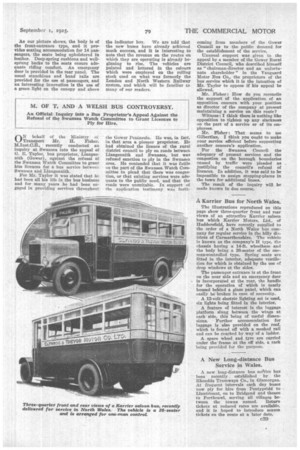BUS RESULTS AT SOUTH SHIELDS.
Page 22

Page 23

If you've noticed an error in this article please click here to report it so we can fix it.
Details of the Efforts which are Being Made by the Municipal Authorities to Bring About an Improvement in the Financial Returns of the Bus Services.
TEM ANNUAL report of the South Shields Corporation dealing with the municipal passenger transport services shows that a loss of 13,941 was recorded on the buses during the year ended March 31st last. Receipts on the buses amounted to £3,591, whilst the expenditure was £6,056, the deficit thus being L2,465 as against £239 a year ago. After meeting interest and redemption charges, the loes on the
buses is brought up to the figure • already mentioned. The number of passengers carried on the municipal vehicles was 18,140,900. The average journeys per head of population per annum dropped to 143—au index of the effects of the industrial depression and • consequent unemployment. The report mentioned that the six buses owned by the department had been efficiently maintained.
The loss which has bean incurred was foreshadowed some time ago, and it will he "remembered that in the early . part of dune the corporation adopted a proposal of its general manager and engineer to purchaSe a small fleet of oneman-controlled 14-scater Morris buses on pneuniatic tyres; in an endeavour to eliminate the losses. The corporation services have been subjected to considerable Competition, to meet which the
• tramways committee has, as mentioned in our issue of August 18th, prepared ' a list of conditions which it is recommended should be imposed by the local watch committee in granting licences for bus services. '
The Morris • buses are now being placed in service, and the type of vehicle which is being employed is shown in the accompanying illustration.. They are being placed in service to meet a public demand for a fast and frequent service on a route which has a low density of population per bus-mile, but with prospects of better business if adequate facilities are available.
The buses were constructed to the specification of Mr. J. Austin Baker, the general manager and engineer, by Morris Commercial Cars, Ltd., of Soho, Birmingham. The chassis is the manufacturers' 1-ton model, which is driven by a four-cylinder engine with a bore of 75 tam, and a stroke of 102 ram., and develops 28 h.p. •
As our picture shows, the body is of the front-entrance type, and it provides seating accommodation for 14 passengers, the seats being upholstered in leather. Deep-spring cushions and wellsprung backs to the seats ensure adequate riding comfort. An emergency door is provided in the rear panel. The usual stanchions and hand rails are provided for the use of passengers, and an interesting innovation is the use of a green light on the canopy and above the indicator box. We are told that the new buses have already achieved much success, and it is interesting to note that the revenue on the routes on which they are operating is already beginning to rise. The vehicles are painted and lettered in the colours which were employed on the rolling stock used on what was formerly the London and North Western Railway system, and which will be familiar to many of our readers.




























